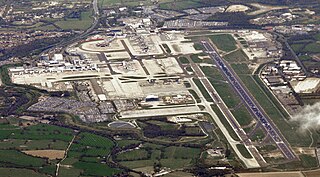History
Air Ministry Constabulary
Civilian airports in the United Kingdom were originally under the control of the Air Ministry, which was mainly concerned with the operation of the Royal Air Force, but was also responsible for non-military aviation. During this time, airfields and aerodromes were policed by the Air Ministry Constabulary, who were sworn in as special constables under section 3 of the Special Constables Act 1923. [1] In 1946, F. J. May OBE was appointed as the first Chief Constable, and Squadron Leader D. F. Grierson MBE was appointed as Deputy Chief Constable. [2]
Ministry of Civil Aviation Constabulary
After World War II, the rise in civil aviation saw the creation of the Ministry of Civil Aviation in 1946, and Heathrow Airport was brought under the ministry's control that year. The Ministry of Civil Aviation Constabulary was formed in 1948, and its first chief constable (appointed that year) was Sir John Bennett, a former Inspector-General of Police for the province of Punjab, India. [3] Bennett died in June 1949, and was replaced by W. Ronnie who had been deputy chief constable under Bennett, prior to which he was the Chief Constable of Breconshire Constabulary, and a member of Buckinghamshire Constabulary from 1927 to 1947. [4] Members of the Civil Aviation Constabulary were sworn in as special constables under section 37 of the Civil Aviation Act 1949. [5]
British Airports Authority Constabulary

The British Airports Authority was established in 1965 by the Airport Authority Act 1965, and on 1 April 1966 the new British Airports Authority Constabulary (BAAC) took on responsibility for operating London Heathrow, London Gatwick and London Stansted airport. [6] [7] The change of administration was seen as an opportunity to partially reform old working methods, and then-novel innovations were introduced, such as report forms with tick-boxes, an index card system and dictation machines for detectives. [6] In December of that year, the strength of the force stood at 201. [6] In 1969 the Chief Constable, Major W. Ronnie, was awarded the Queen's Police Medal. [8] BAA took on Edinburgh Airport in 1971, and Aberdeen Airport and Glasgow Airport in 1975. [9] By mid-1970, the strength of the BAAC stood at 326, of which 28 were women. [6]
BAAC constables were sworn in under section 10 of the Airport Authority Act 1965. [10] They were attested before a justice of the peace (or a sheriff in Scotland), and had "the powers and privileges and [were] liable to the duties and responsibilities of a constable" on all the aerodromes owned or managed by BAA. [10] They also enjoyed their powers when following (pursuing) a person from such an aerodrome, if they could have arrested them on the aerodrome. [10] BAA had the power to sack or suspend constables, and were vicariously liable for their actions. [10] In April 1971, R. M. Carson was appointed as Chief Constable of the BAAC. [11]
Municipal airport police forces
However, not all major airports were under the control of BAA. In 1961, control over Liverpool Airport had passed from the Ministry of Civil Aviation to Liverpool City Council, who established Liverpool Airport Police in that year. [12] Separate police forces were also maintained for Manchester Airport (Manchester Airport Police) from 1954 [13] to 1976, [14] Birmingham Airport (Birmingham Airport Police) from 1970 [15] to 1976 [16] and Glasgow Airport from 1969 [17] to 1975. Belfast International Airport have operated a separate police force, Belfast International Airport Constabulary, since 1971, [18] which still exists today.
Members of all the police forces had full police powers whilst on the airport (in the case of Birmingham Airport Police, their powers extended when in pursuit of a person from the airport as with BAAC). [15]
Liverpool Airport Police were effectively disbanded in 1974, when political change at the city council saw Liverpool Parks Police merged with the airport police into a civilian "Liverpool City Security Force". [12]
Police forces were also maintained by Teesside Airport, Aberdeen Airport (pre-BAAC), East Midlands Airport, Luton Airport and Southend Airport.










